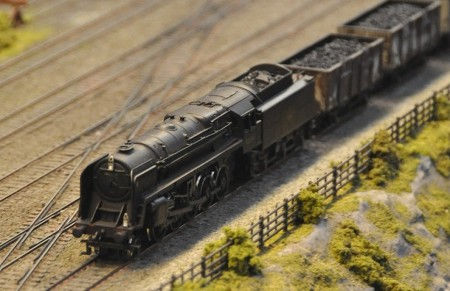
MODEL RAILWAY CLUB
Established 1966
The layout started life as three baseboards with some track donated to the club. Over the years it has been gradually extended and now appears in its new form as a continuous circuit.
Woolston depicts a secondary line in the North of England. The survival of the line is mainly due to the mineral traffic from Woolston Quarry together as a diversionary route during engineering works. The scene is set in late 1950’s / early 1960’s, with locomotives and stock from the London Midland and Eastern Regions represented.
Beyond Woolston Station can be found the loading area and exchange sidings of Cockin & Brown Quarries Limited. The line curves through the works before entering the narrow tunnel of Neville Brow. A narrow gauge track runs from the quarry head via a girder bridge into the crushing plant.
Most of the buildings have been scratchbuilt with some using modified kits. The backscene is made up of an arrangement of calendar / picture book illustrations to create the surrounding countryside. The layout features operating signals and level crossing gates. You might see wagons being loaded in the quarry prior to transportation.
WOOLSTON

4mm Scale OO gauge 19 X 6 feet

_JPG.jpg)
_JPG.jpg)
.jpg)
.jpg)
Click on pictures for larger image
GLAZEBROOK
2mm Scale N gauge 14 X 3.5 feet
A model of one of our local stations, now sadly little more than a bus shelter. In the fifties the goods yard was still open, as was the branch to Wigan. At that time the line was largely worked by ex LMS locomotives plus DMUs, rolling stock for a slightly earlier period provides greater variety being largely ex LNER and GC in particular. Grand National day gives a license to run almost anything!
Traffic was generally heavy, with trains to and from Stockport and Wigan passing through and crossing the paths of those on the main line from Manchester to Liverpool.
DIENW
4mm Scale OO9 gauge 12 X 2 feet
PENKETHMAWR
4mm Scale OO gauge 16 X 8 feet
Penkethmawr is a “modern image” layout currently under construction by a team of 6 club members.
The layout represents a stretch of double track mainline passing alongside a ballast loading facility for both rail and road export. Ballast is transported to the facility by conveyor or tipper truck from a nearby quarry.
Over the years the site has been dramatically rationalised and two rail sidings, previously used for ballast traffic, now form the basis of a modest general freight depot, including container handling.
Penkethmawr has a small un-manned station allowing the local community to benefit from a frequent DMU service to towns further along the mainline.
The layout is a continuous circuit with an eleven road fiddle yard. Trackwork is Peco Streamline Code 100 with Seep and Peco point motors. Operation of locomotives is by Digital Command Control (DCC).
WALTON MOOR SIDINGS
4mm Scale OO gauge 28 X 8 feet
This layout represents a busy main line on Walton Moor somewhere in the northern hills. The tracks were quadrupled in the 1890s when exchange sidings were laid out for the steeply graded mineral branch. There is heavy passenger and freight traffic and the route is often used for diverted trains during engineering works on other lines. The area is quite sparsely populated and therefore there are not many dwellings although the small village of Walton Moor can be seen in the distance.
This layout runs with members’ rolling stock and therefore quite a variety of trains will be seen representing both steam and diesel operation. Essentially it is a layout to watch the trains go by!
The layout boards were constructed using a plywood open frame design. The landscape was formed with a polystyrene based covered with a pre-coloured plaster based. Vegetation is from a variety of sources. The trackwork is PECO finescale and all pointwork on the front is controlled from a central operating panel. The fiddleyard is controlled independently.
Walton Moor has recently been dismantled and a replacement layout is in the planning / construction stage.
The station area and yard are being modelled to scale, to make the layout easily transportable, the west junction area has been selectively compressed. Although a relatively small station the prototype track plan managed to include both single and double slip points.
Background History
The year is 1943 and Britain is at war with Germany. Under wartime emergency conditions all station names have been removed. The purpose was to cause the maximum amount of confusion to enemy paratroopers, (who were expected to drop from the skies at any moment disguised as nuns). An unfortunate consequence was the confusion of the passengers, officials and lines management.
Location
Somewhere in North Wales, (Sorry can’t be more precise, there’s a war on you know!) there is a little-fach (small railway) doing its best against the enemy. (The Germans, not the English for once.) The line has received a major boost in traffic from the new mysterious military building, rumoured to have something to do with explosives. all the locals know for sure is that it receives many trains of military supplies.
This little junction on its main line, with the branch line going off to Llan CENSORED is like many narrow gauge lines, alternating between absolute quiet and complete mayhem.
The line is of course fictitious, although some items of rolling stock may be identifiable. These of course have been transferred from their proper homes to assist with the war effort (Well that’s our excuse anyway).




















